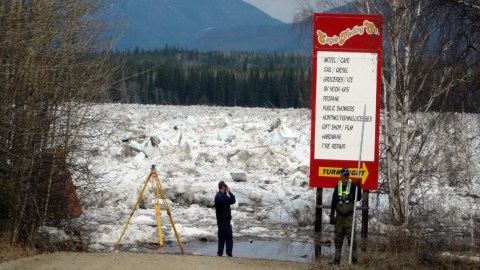Record Warm Weather in Alaska’s Interior a Cause for Concern

Unless you live there, the city of Eagle, Alaska, is far, far away. Here it is on a map:

That’s about as middle-of-nowhere as you can get, Antarctica notwithstanding.
As you can probably imagine, Eagle is typically known for three things. The first: its history as a Gold Rush boomtown. The second: that only about 90 people live there. The third: that you have no reason to expect the outside temperature to be 91°F (33°C) on May 23. Those three things (among other ancillary details) form the foundation of everything that is Eagle.
Gold Rush. Low population. Not 91°F on May 23.
Got that? Good, because:
The Coop station in Eagle, Alaska, reached 91°F yesterday. That is hotter than any day in #Houston or #Dallas, TX, this year. #akwx#txwx
— Brian Brettschneider (@Climatologist49) May 24, 2015
Oy vey.
Over at ATTN, Laura Donovan has an interesting piece on the unusually high temperatures that soared across Alaska's interior over Memorial Day weekend. In the case of Eagle, the atypical heat represented a spike within a longer, concerning trend of climate shifts within the region:
"Eagle's temperatures have risen since 1981... Eagle's record-breaking May 23 temperature was 30 degrees hotter than the average daily high temperature in May and almost 20 degrees hotter than the average high temperature in July, which is the town's warmest month of the year."
The National Weather Service noted that Fairbanks Airport, about 200 miles (315 km) away, broke its own heat record by a staggering 6 degrees Fahrenheit. The only places in the United States hotter that day were the Gulf Coast, West Texas, and the Mojave Desert. It's not often that the Alaskan interior is among the warmest regions in the country!
Donovan explains why this trend bothers climate scientists:
"Though warmer days get people excited about the start of summer, unseasonably hot weather can pose serious dangers to unprepared towns. The Alaska Interagency Coordination Center issued a Fuels and Fire Behavior Advisory on May 23 to warn Alaska's eastern interior about potential fires in the area."
Warm spring weather in this region also heightens the risk of costly floods and water damage due to rapid melting of snow and ice. Eagle Village, located immediately next to Eagle, was completely destroyed in 2009 by Yukon River floods, its 70 residents (including many Hän Native Alaskans) forced to scramble to watch their roofs float away. The area flooded again in 2013. In the event that climate trends continue to shift, there might soon come a time when the folks who have called this area home for hundreds of years will be forced to pick up and leave.
Read more at ATTN.
Below, EPA Administrator Gina McCarthy discusses the role the U.S. federal government can play in combating climate change:
Photo credit: Alaska State Troopers via Getty Images




